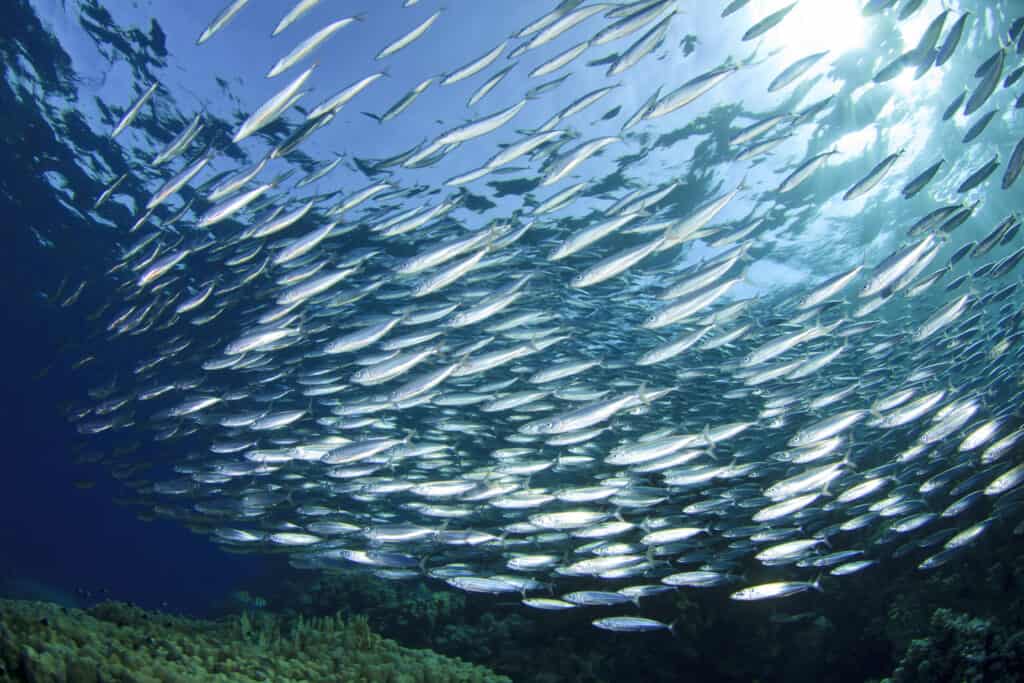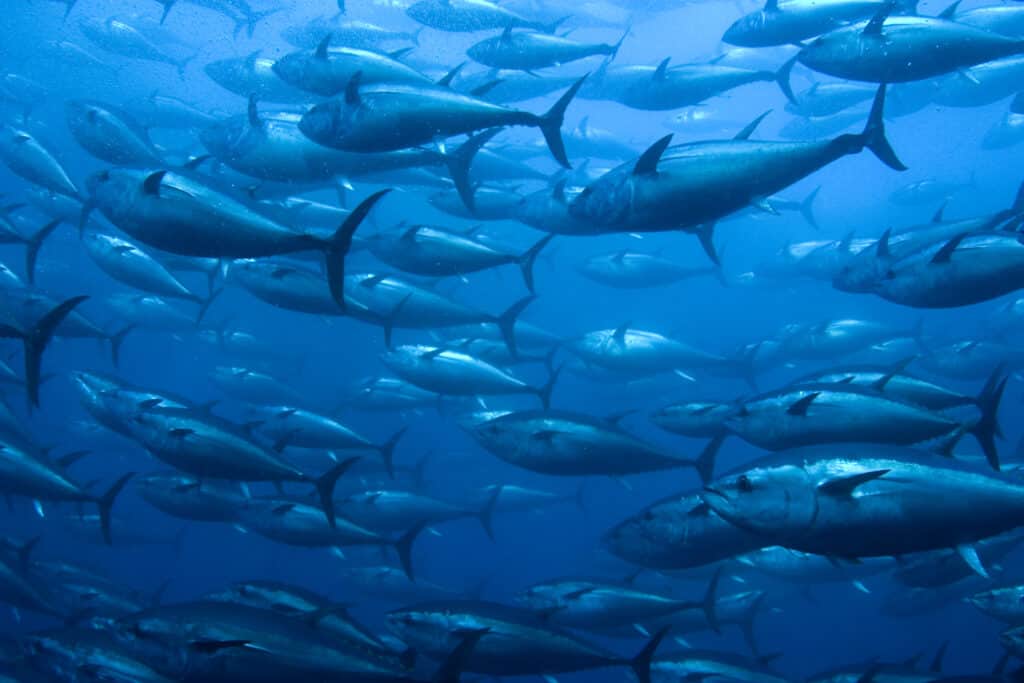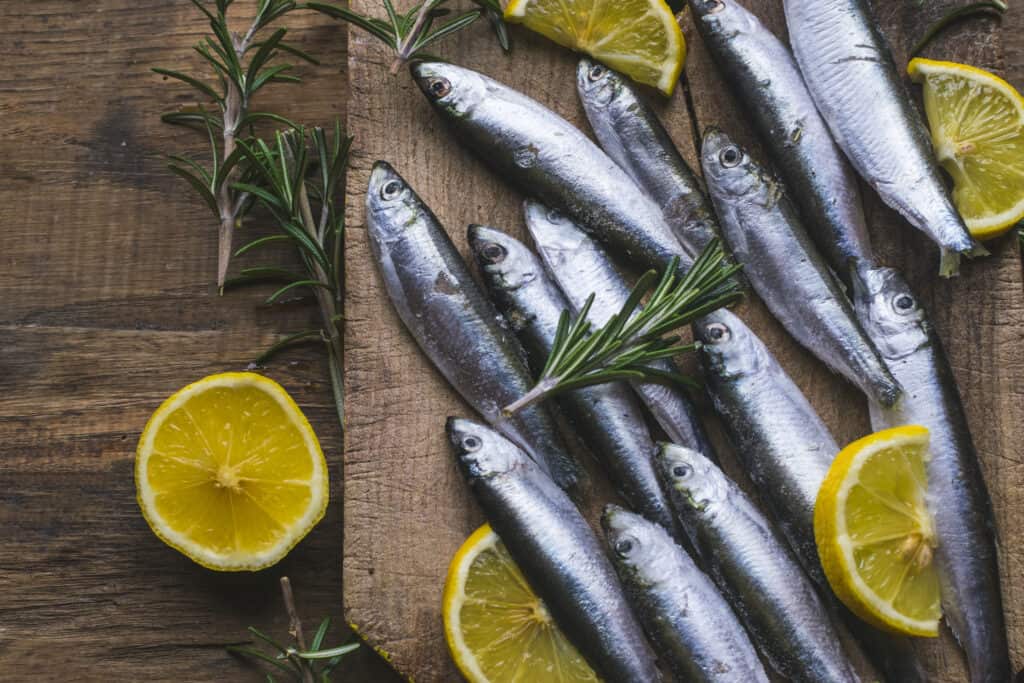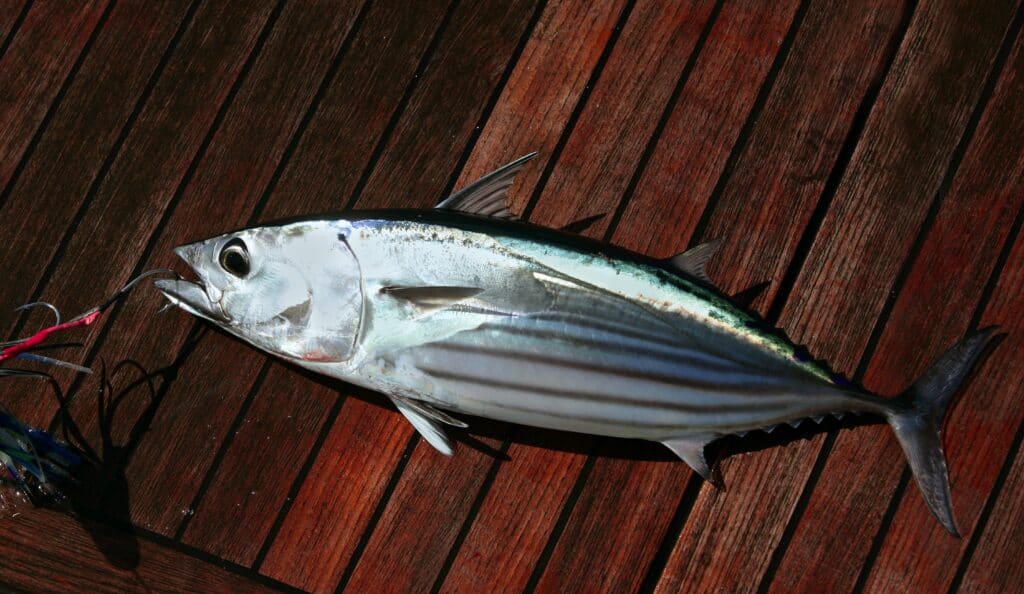The oceans are filled with fish of all sizes, and many of them have become well-known because people have developed an appetite for them. Two famous fish in the world today are sardines and tuna. The former is known for being an inexpensive canned fish that is best served in olive oil. Tuna is another type of fish that is preserved in cans and served either as an inexpensive meal or as a delicacy, depending on the fish. Today, we will examine the differences between sardines and tuna and show you several of the main differences between the two.
Comparing Sardines vs Tuna

Sardines are small fish from five different genera that only reach about 12 inches and 4.5 pounds at their largest.
©iStock.com/richcarey
| Sardines | Tuna | |
|---|---|---|
| Size | Weight: 0.2-4.5 pounds Length: 6-12 inches | Weight: 3-1,500 pounds Length: 1.5-15 feet |
| Diet | – Zooplankton, phytoplankton, crustacean eggs, decapods, and fish eggs | – Shellfish, eels, lobster, jellyfish, shrimp, and several other fish. |
| Scientific Families | – From genera Sardina, Dussumieria, Escualosa, Sardinops, and Sardinella | – From genera Thunnus, Auxis, Allothunnus, Euthynnus, and Katsuwonus. |
| Uses | – Canned – Served whole and fresh – Baked into pies – Frequently smoked and then served | – Frequently canned – Served as a delicacy in sushi and sashimi – Cooked as a steak – May be served fresh or frozen as well as raw or cooked |
| Nutritional Information | – High in vitamins B2, B12, and D along with potassium, phosphorous, and others – A good source of omega-3 fatty acids – A good source of protein – Exceptionally low mercury levels compared to other fish- | Relatively high in mercury content due to place in the food chain – High in protein – Source of omega-3 fatty acids – Moderate levels of vitamin A and D, but high in Vitamin Bs. – Good source of iron, phosphorous, and selenium. |
The Key Differences Between Sardines vs Tuna
The greatest differences between sardines and tuna include their size and families.
Sardines are small fish from five different genera that only reach about 12 inches and 4.5 pounds at their largest, but tuna can weigh anywhere from 3 pounds to 1,500 pounds and measure up to 15 feet long. Tuna also come from five different genera but do not share any of the same families as sardines.
These massive differences make it easy to tell these creatures apart. We’re going to dig deep into five differences between them to show you just how unique these fish are despite both being popular foods for people.
Sardines vs Tuna: Scientific Families

Tuna measure anywhere between 1.5 feet and about 15 feet at their largest.
©iStock.com/LUNAMARINA
Both sardines and tuna come from five different genera of fish, but neither of them shares a family with the other. True sardines are in the Sardina, Dussumieria, Escualosa, Sardinops, and Sardinella genera.
However, tuna from the Thunnus, Auxis, Allothunnus, Euthynnus, and Katsuwonus genera. The fish called true tuna only come from Thunnus, and that genus is broken down into two subgroups. All told, about 15 species of tuna and 14 genera are recognized as commercially significant. These fish do not share any genus, family, or subtribe.
Sardines vs Tuna: Size

Sardines are small filter feeders, so they mostly eat zooplankton.
©iStock.com/PicturePartners
Tuna are heavier and larger than sardines. An average sardine weighs anywhere from 0.2 to 4.5 pounds and only grows about 6 to 12 inches in length. Tuna weigh anywhere between 3 pounds and 1,500 pounds at their largest, so even the smallest tuna has a higher average weight than a sardine.
Also, tuna measure anywhere between 1.5 feet and about 15 feet at their largest. The largest bluefin tuna ever caught weighed 1,496 pounds! That should give you some idea of how big these fish can grow.
Sardines vs Tuna: Diet

Tuna’s preferred foods include crab, crayfish, eels, herring, sardines, jellyfish, octopus, shrimp, and many others.
©iStock.com/DeepAqua
Tuna and sardines also stick to very different diets compared to each other. Sardines are small filter feeders, so they mostly eat zooplankton. However, they also eat fish eggs, barnacles, small mollusks, and even phytoplankton. Their small size makes it so they can only eat very small things.
Tuna eat a variety of other sea creatures. Their preferred foods include crab, crayfish, eels, herring, sardines, jellyfish, octopus, shrimp, and many others. Eating all these other animals helps them achieve their large sizes.
Sardines vs Tuna: How Humans Use Them

Sardines are usually packed in a tin after being smoked or otherwise cooled.
©iStock.com/Ralers
Tuna and sardines are fishes humans pull from ocean waters and consume. However, they’re not always consumed in the same manner. The greatest overlap is that tuna and sardines are popular canned fish, but whole sardines are usually packed in a tin after being smoked or otherwise cooled. However, a small portion of processed, cooked tuna is usually put in a can.
Aside from being popularized as a tinned fish that can be served cold on sandwiches and salads, tuna is sometimes served as a delicacy. Specifically, tuna is integral in some recipes for sushi and sashimi. Sometimes, this fish is also cooked as a large steak. So, this fish can be served raw or cooked, and it can be fresh or frozen.
Sardines are often served after being canned, smoked, or baked into a pie. They can be eaten raw, though. Many times, these fish are served both whole and fresh. Sardines are not considered a prized delicacy like tuna, though. Those fish are small, common, and inexpensive.
Sardines vs Tuna: Nutritional Information

Tuna contains a relatively large amount of mercury.
©iStock.com/LUNAMARINA
Tuna is a healthy food choice, but it’s not something most people would want to eat every week. Since this fish consumes large portions of other fish, it contains a relatively large amount of mercury. Since mercury is hazardous to human health, repeatedly indulging in fish high in mercury can potentially lead to health problems.
Still, tuna is high in protein, omega-3 fatty acids, and Vitamins B and A. This fish is also a good source of iron, phosphorous, and selenium.
Sardines do not have a lot of mercury in them, so they’re healthier in that regard. They mostly survive on plankton. They offer high values in vitamins B2, B12, and D. These fish also contain a fair amount of omega-3 fatty acids, potassium, and phosphorous.
Both fish are good for humans to eat, but tuna is much higher in mercury.
Now that we’ve looked at sardines vs tuna, it should be clear that they’re very different fish. While tuna are large fish that eat other fish and are served as a delicacy, sardines are small fish that primarily eat plankton while being an inexpensive, healthy meal.
Up Next:
- Bigeye Tuna vs Bluefin Tuna: The Key Differences Explained
- Ahi Tuna vs Yellowfin Tuna: What are the Differences?
- Skipjack Tuna vs Albacore Tuna: 6 Key Differences
- Ahi Tuna vs Bluefin Tuna: Key Differences Explained
The photo featured at the top of this post is ©
Sources
- Agricultural Research Service U.S. DEPARTMENT OF AGRICULTURE, Available here: https://www.ars.usda.gov/plains-area/gfnd/gfhnrc/docs/news-2013/eat-fish-which-fish-that-fish-go-fish/
- Springer Nature Switzerland AG, Available here: https://link.springer.com/article/10.1007/s00227-004-1541-1
- U.S. DEPARTMENT OF AGRICULTURE, Available here: https://fdc.nal.usda.gov/fdc-app.html#/food-details/172006/nutrients
- Washington Department of Fish and Wildlife, Available here: https://wdfw.wa.gov/fishing/commercial/purse-seine-sardine/biology
Thank you for reading! Have some feedback for us? Contact the AZ Animals editorial team.







